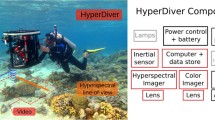Abstract
PSWIMS (ProfilingShallowWaterInstrumentMountingSystem) is a relatively simple instrumentation system that has been developed to remotely collect vertical profiles of physical and chemical parameters in shallow water that is subject to significant changes in depth. The system is designed for observations that can not practically be made with moored sensors (due to the high cost of multiple sensors, the physical size of sensors, or the inability of moored instruments to accommodate changes in water depth) or with hand held sensors (due to the need for frequent observations over extended periods of time). Results are presented from two field deployments that demonstrate the utility of PSWIMS for measuring horizontal flux and for monitoring water quality parameters in shallow water.
Similar content being viewed by others
Literature Cited
Honji, H., A. Kaneko, andK. Kawatate. 1987. Self-governing profiling system.Continental Shelf Research 7:1257–1265.
Kirby-Smith, W. W., S. J. Eisenreich, J. T. Howe, and R. A. Luettich, Jr. 1992. Agricultural runoff into estuarine systems: Fates and effects of herbicides and pesticides. Final Report to United States Environmental Protection Agency Environmental Research Laboratory, Gulf Breeze, Florida.
Luettich, R. A., Jr.,D. R. F. Harleman, andL. Somlyódy. 1990. Dynamic behavior of suspended sediment concentrations in a shallow lake perturbed by episodic wind events.Limnology and Oceanography 35:1050–1067.
Officer, C. B. 1976. Physical Oceanography of Estuaries (and Associated Coastal Waters). John Wiley, New York. 465 p.
Pietrafesa, L. J., G. S. Janowitz, T. Y. Chao, R. H. Weisberg, F. Askari, and E. Noble. 1986. The physical oceanography of Pamlico Sound. University of North Carolina Sea Grant Publication UNC-WP-86-5, Raleigh, North Carolina. 125 p.
Pitts, P. A. 1989. Upwind return flow in a coastal lagoon: Seasonal-scale barotropic transport.Estuaries 12:92–97.
Prichard, D. W. 1989. Estuarine classification—A help or a hindrance, p. 1–39.In. B. J. Nelson, A. Kuo, and J. Brubaker (eds.), Estuarine Circulation. Humana Press, Clifton, New Jersey.
Schroeder, W. W. andW. J. Wiseman. 1988. The Mobile Bay estuary: Stratification, oxygen depletion, and jubilees, p. 41–52.In B. Kjerfve (ed.), Hydrodynamics of Estuaries, Vol. II. CRC Press, Boca Raton, Florida.
Uncles, R. J., R. C. A. Elliott, S. A. Weston, D. A. Pilgrim, D. R. Ackroyd, D. J. McMillan, andN. M. Lynn. 1986. Synoptic observations of salinity, suspended sediment, and vertical current structure in a partly mixed estuary, p. 58–70.In J. van de Kreeke (ed.), Physics of Shallow Bays and Estuaries. Springer-Verlag, Berlin.
Author information
Authors and Affiliations
Rights and permissions
About this article
Cite this article
Luettich, R.A., Kirby-Smith, W.W. & Hunnings, W. PSWIMS, a profiling instrument system for remote physical and chemical measurements in shallow water. Estuaries 16, 190–197 (1993). https://doi.org/10.2307/1352490
Received:
Accepted:
Issue Date:
DOI: https://doi.org/10.2307/1352490




